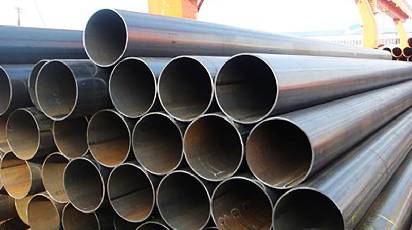Steel pipe production technology development began with the rise of the bicycle manufacturing, oil development in the early 19th century, two world wars ships, boilers, aircraft manufacturing, after the second world war thermal power boiler manufacturing, chemical industry and the development of oil and gas drilling and transportation, effectively driving the steel pipe industry in the development of varieties, yield, and quality. Usually, according to the production method, the steel pipe is divided into a seamless steel pipe and welded steel pipe. This time, we mainly introduce the welded steel pipe.
Welded steel pipe is the welded steel pipe, its production is the tube billet (steel plate and steel belt) with a variety of forming methods to bend and roll the required cross-section shape and size of the tube, and then use different welding methods to weld the process of steel pipe. Compared with seamless steel pipe, the welded pipe has high product precision, especially the wall thickness precision, the main equipment is simple, occupies a small area, the production can be continuous operation, the production is flexible, the unit product range is wide and so on.

Electric Resistance Welded Pipe
The Welded Steel pipe shall be divided from the production process, and then divided into welded steel ssaw spiral pipe; lsaw carbon welding steel pipe; electric resistance welded pipes.
The production process of the spiral steel pipe is rough as follows
● spiral steel tube raw materials, namely strip coil, welding wire, flux.
● before forming the strip after leveling, cutting, planing, surface cleaning conveying and bending treatment.
● the use of the weld gap control device to ensure that the weld gap to meet the welding requirements, pipe diameter, the number of wrong side and weld gap are strictly controlled.
● after cutting into a single steel pipe, each batch of steel pipe head three to carry out a strict first inspection system, check the mechanical properties of the weld, chemical composition, melting condition, the surface quality of the steel pipe and through non-destructive inspection, to ensure that the piping process qualified, can be formally put into production.
Two, straight seam submerged arc welding pipe
In general, LSAW is made of steel plate through different forming processes and forms welded pipe through double-sided submerged arc welding and post-welding expansion.
The main equipment is edge milling machine, pre-bending machine, forming machine, pre-welding machine, expanding machine, and so on. At the same time, the forming mode of the straight seam submerged arc welding pipe includes UO (UOE), RB (RBE), JCO (JCOE), and so on. The steel plate is first pressed into a U shape and then into an O shape in the forming die and then submerged arc welded inward and outward, usually at the end or full-length range Expanding (Expanding), or UOE welded pipe if it is not Expanding, or UO welded pipe if it is not Expanding. The steel sheet will be rolled and bent into shape, and then the inner and outer submerged arc welding will be carried out. After welding, the expanding diameter will be RBE welded pipe or RB welded pipe. Shape the steel plate in the order of j-c-o, and then enlarge the diameter to JCOE welded pipe or JCO welded pipe without expansion.
The forming process of UOE straight seam submerged arc welding pipe:
The three main forming processes of the UOE straight seam submerged arc welding pipe forming process include the pre-bending of steel plate, U forming, and O forming. Special forming presses are used in each process to complete the three processes of pre-bending, U forming and O forming at the side of the steel plate, and then the steel plate is deformed into a circular tube.
JCOE straight seam submerged arc welding pipe forming process:
Forming: after many steps of stamping on JC0 molding machine, the first half of the steel plate is pressed into a "J" shape, and then the other half of the steel plate is pressed into a "J" open, forming a "C" shape, and finally from the middle of the pressure to form an open "0" shape tube billet. As shown in the figure:
Comparison of molding methods between JCO and UO:
JCO is formed by progressive pressure forming, which changes the forming process from two steps at UO to several steps. In the forming process, the steel plate is deformed uniformly, the residual stress is small, and the surface is not scratched. The machined steel tube has greater flexibility in the diameter and wall thickness of the size range, can produce both large quantities of products, also can produce small quantities of products; It can produce both large-caliber and high-strength thick-wall steel tubes and small-caliber and large-wall steel tubes. Especially in the production of high steel grade thick wall tube especially in the medium and small diameter thick wall tube has the advantage of other technology incomparable. Can meet the user in the steel pipe specification more requirements. The investment is small, but the production efficiency is low, generally, the annual output is 100,000-250,000 t.
UO molding, U, and O two pressure molding, its characteristics are large capacity, high output, the general annual output of up to 300,000-1,000,000 t, suitable for a single specification of mass production. The investment is too large for developing countries to bear.
Three, straight seam high-frequency welded pipe
Straight seam high frequency welded pipe (ERW) is produced by heating and melting the edge of the tube billet using the skin effect and proximity effect of the high-frequency current after the hot-rolled coil is formed by the forming machine, and then by pressure welding under the action of the extrusion roller.
